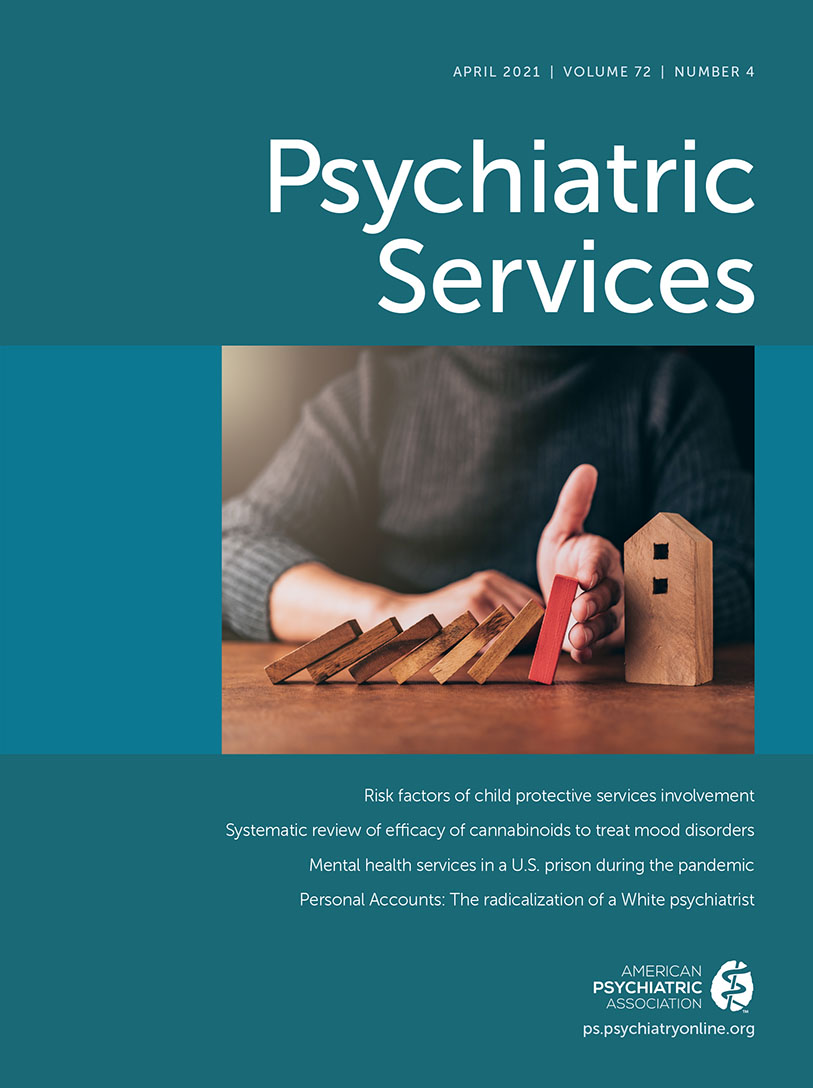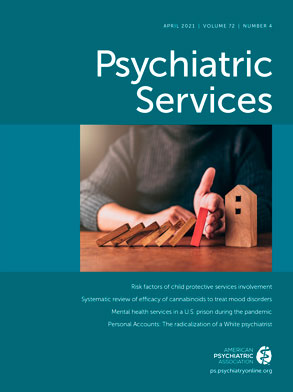Shared decision making (SDM) aims to facilitate patient-centered care and treatment adherence by promoting joint treatment decision making between patients with chronic conditions and clinicians (
1). In mental health care, SDM has been recommended for people with serious mental illness, given that self-determination, choice, and autonomy are core aspects of recovery-oriented care (
2,
3).
Despite the proliferating development of SDM interventions (
2), SDM implementation for patients with serious mental illness has been relatively less successful than for other groups. This disparity has been attributed to a variety of barriers (
4), including clinicians’ paternalistic approach to care of patients with serious mental illness and stigma-related beliefs that SDM is inappropriate for such patients. Unlike other chronic nonpsychiatric conditions, the characteristics of serious mental illness may pose a major barrier to SDM implementation. For example, psychotic symptoms and cognitive deficits associated with schizophrenia can affect decision-making capacity and serve as barriers to SDM, whereas an elevated blood-glucose level associated with diabetes does not stop patients from being involved in SDM. Another potential barrier to SDM among patients with serious mental illness is negative internalized self-stigma, a common experience that leads patients to underestimate their own competency for decision making and autonomy (
5,
6).
A greater barrier, though, may be clinicians’ fear of liability and legal exposure. Clinicians may resist SDM with patients with serious mental illness because they fear being held liable for any potentially negative outcome that might result from SDM, such as symptom exacerbation, hospitalization, or death. Burnout, patient load, and limited appointment time also contribute to clinicians’ reluctance to engage in SDM (
4).
Although promising, research and implementation of SDM in mental health care have overlooked the fact that SDM is sometimes at odds with clinicians’ training to mitigate the risk of harm and with organizational policies that are inherently risk averse. To promote the implementation and usage of SDM with people with serious mental illness, clinicians must acknowledge and directly confront issues of risk, which are inherent in psychiatry and which hinder SDM with individuals who have serious mental illness. In this Open Forum, we offer a new conceptualization, shared risk taking, as a unique way to view SDM with people with serious mental illness. We argue that risks are an inevitable part of the SDM process and are not related only to the decision at hand and that joint reflection by the clinician and patient should be used to address SDM-related risks.
Inherent Risks in Serious Mental Illness Management and Recovery
Across many psychiatric settings, different levels of risk and standards of risk management are used to mitigate harm and minimize negative health outcomes while prioritizing management of some risks over others. In psychiatry, reducing risks to safety is the highest priority, because it is a key part of one aspect of clinicians’ professional training and responsibility and is the common institutional policy among mental health services. Perceived risks to safety affect both clinicians and patients, but differently. For clinicians, safety risks, such as relapse, present high potential for legal liability, particularly if the risk is accompanied by symptoms potentially related to harm, such as suicidality or homicidality. For patients, these risks may take the form of reduced quality of life, which might stem from symptom exacerbation, hospitalization, or the psychological or potentially permanent physical side effects of treatment (
7).
Yet the path to recovery from serious mental illness requires more than minimizing safety-related risks. Recovery-oriented care involves a broad array of risks inherent in all domains of patients’ lives, such as employment, education, and relationships. For a patient, a decision to stop working poses economic and mental health risks, whereas returning to work after a psychiatric hospitalization may be associated with high risks of humiliation or failure, which pose other sets of emotional and psychological risks. Nevertheless, recovery-related decisions do not usually pose significant risks for either clinician or patient, and SDM can be encouraged. Therefore, there is a greater chance of successfully implementing and using SDM in recovery-related decisions, such as those concerning employment or education, and a lower chance of using SDM in health-related decisions, such as tapering medications, that involve safety risks for both patients and clinicians.
Shared Risk Taking
With the understanding that risk is both unavoidable and a core element of any decision (
8), the challenges of SDM for persons with serious mental illness become apparent. How should clinicians and patients make decisions with potentially negative outcomes or when a patient’s decision-making capacity is unclear? These dilemmas point to the reality that in some situations and for some decisions, joint decision making with people with serious mental illness will likely involve decisions about risk and thus might be better characterized as shared risk taking.
We introduce shared risk taking as a new perspective that aims to emphasize the often-overlooked risks associated with SDM with patients with serious mental illness that might inhibit SDM usage, implementation, and effectiveness. For example, clinicians might involve patients in choosing between different medications but will not present the option of abstaining from medication (
9). Patients, for their part, might conceal certain information relevant to SDM from their clinician—for example, that they have tapered or stopped taking their medications—to avoid the risk of losing disability stipends or other benefits or of being seeing negatively by the psychiatrist (
10). We offer shared risk taking as a way to attend to, via processes of intersubjectivity and metacognition, unspoken risks that the SDM literature does not explicitly discuss or offer ways of addressing.
In shared risk taking, the clinician and patient should jointly reflect on the inherent risks of any decision and discuss issues related to the patient’s and clinician’s stigmatizing or paternalistic beliefs regarding their inability to participate in decision making. The clinician and patient should explicitly conduct a risk assessment of the decision, its safety implications, and the patient’s capacity to be involved in the decision making. A shared-risk-taking approach is valuable not only in psychiatry and mental health settings but also in populations of individuals with developmental disorders, Alzheimer’s disease, or drug abuse and even with children, whose capacity for decision making is questioned and who are often exposed to stigmatizing and paternalistic beliefs.
The recognition of risks in SDM with patients who have serious mental illness calls for a deeper exploration of at least two aspects of the SDM process that have been relatively unrecognized. First, SDM focuses more on presenting medical options and discussing their risks and benefits than on sharing emotions pertaining to risk taking. We believe that the success of SDM relies on a set of fundamentally intersubjective patient-clinician processes that involve a shared experience of anxiety, worry, and fear when certain decisions are made (
11). Patients’ and clinicians’ expression of both worries and hopes during SDM can serve as a foundation for joint reflection and can lead to a better decision-making process, an informed decision, and a greater commitment and motivation to attain a positive outcome. Of note, appointment lengths and professional attitudes in some setting are less likely to leave room for sharing thoughts and feelings than in other settings. Nevertheless, we recommend that clinicians at least attempt to share thoughts and feelings related to risk taking when making decisions.
The second aspect of SDM that may have been previously unrecognized involves considering the process of meaning making and the metacognitive abilities that enable it (
12,
13). Certainly, any decision to take a risk must involve meanings assigned to the behavior in question. For example, deciding whether a risk is worth taking when considering discontinuing a medication, seeking a romantic relationship, or applying for a new job must be a function of how meaningful a medication, a relationship, or a new job could be to the decision maker (
8,
14). Often, SDM does not invite broader explorations of meaning, and SDM principles do not adequately translate into existing SDM tools. Thus, to improve SDM in mental health care, clinicians must acknowledge that through joint reflection, risks are given meaning in the context of the patient’s unique life—that is, they are interpreted as more than simply generic medical risks.
Conclusions
There is a gap between recommendations to disseminate and implement SDM in mental health care and the limited use of SDM in practice. We suggest a new conceptualization, shared risk taking, to explain this gap and to facilitate the implementation of SDM and adherence to its principles, when applicable. This is not simply a matter of semantics: reframing SDM as shared risk taking poses important challenges for SDM research and practice. It seems imperative to explore the different experiences of risk for clinicians and patients. Although outside the scope of this Open Forum, future research should explore the institutional and policy factors that both hinder and enable patients and clinicians in making adaptive decisions about risk (
15). Although SDM occurs in the interpersonal-intersubjective patient-clinician interaction, clinicians must manage requirements at both the system and organizational levels simultaneously, which has also been shown to inhibit the adoption of SDM, even when clinicians view the practice favorably. Furthermore, current SDM practice, which often relies on decision aids and decision support tools (
2), is not designed to capture risk taking in the context of complex decisions with broader life implications. Future research should focus on adapting SDM tools to encompass the shared risk of decision making in serious mental illness. Adopting a shared-risk-taking perspective that takes into account patient capacity, metacognition, and the existence of intersubjectivity in the experience of risks can facilitate SDM in mental health care by targeting a blind spot in SDM practice.

